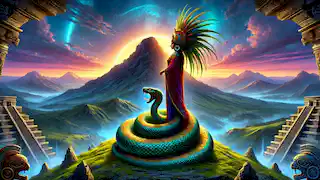In the heart of the ancient Mexica civilization, long before the towering pyramids kissed the sky, there lived a people who revered their gods with the utmost devotion. Among these deities, none was more powerful, more feared, and more respected than Huitzilopochtli, the god of war and the sun. This is the story of his birth, his rise to power, and his ultimate dominion over the lands and the heavens.
Huitzilopochtli, whose name translates to "Hummingbird of the South," was born under circumstances that would forever define his character as a fierce and relentless warrior. His story is interwoven with cosmic elements, sacrifices, and the destiny of his people, the Mexica, who would come to establish the mighty Aztec Empire under his divine protection. It is said that Coatlicue, the Earth Mother, lived atop the sacred mountain of Coatepec. She was the goddess of fertility, symbolizing both life and death, as she could give birth to new life while also demanding sacrifices to nourish the earth. Coatlicue, whose very name means "She of the Serpent Skirt," wore a fearsome garment of intertwined serpents and a necklace adorned with skulls and severed hands, representing her connection to both the physical and spiritual realms. One fateful day, as Coatlicue was sweeping the temple atop Coatepec, a miraculous event occurred. From the heavens, a ball of feathers floated down and landed gently in her apron. Without understanding its origin, she tucked the feathers away, and soon after, she found herself with child. Her other children, the four hundred stars of the southern sky, known as the Centzon Huitznahua, were enraged when they learned of her pregnancy. They were led by their sister, Coyolxauhqui, a moon goddess with immense power. Coyolxauhqui was furious, convinced that their mother had dishonored them by becoming pregnant under mysterious circumstances. Together, they conspired to kill Coatlicue and the unborn child, believing it was the only way to preserve their honor. However, Huitzilopochtli, still in his mother’s womb, was aware of the plot against them. He spoke to his mother, reassuring her that he would protect her. With each passing moment, his strength grew, and when the time came for the confrontation, he would be ready. The day finally arrived when Coyolxauhqui and the Centzon Huitznahua gathered at the base of Coatepec to launch their attack. As they ascended the mountain, their weapons glistening under the moonlight, Coatlicue trembled in fear. But Huitzilopochtli, sensing the danger, was born fully grown and armed, brandishing his mighty weapon, the xiuhcoatl, or fire serpent. In a blinding flash, Huitzilopochtli leaped into action. He struck Coyolxauhqui with such force that he decapitated her, sending her body tumbling down the mountain in pieces. Her head flew into the sky, becoming the moon, forever chased by her brother, the sun. The Centzon Huitznahua, seeing the brutal defeat of their leader, attempted to flee, but Huitzilopochtli was relentless. He pursued and killed them all, casting their bodies into the sky where they became the stars of the Milky Way. The mountain of Coatepec became a symbol of this celestial battle, representing the eternal struggle between day and night, light and darkness, life and death. Huitzilopochtli, victorious and covered in the blood of his enemies, was now the undisputed god of war and the sun. His power would only grow as the Mexica people came to worship him as their chief deity. The Mexica, who would later become known as the Aztecs, were a nomadic people in search of a homeland. They believed that Huitzilopochtli guided their every step, communicating with their priests and leaders through omens and visions. The god promised them a great empire, but only if they followed his divine will with unwavering loyalty. For many years, the Mexica wandered through the Valley of Mexico, facing hardships and battles with rival tribes. Yet, Huitzilopochtli’s prophecy kept them moving forward. The god had told them they would know they had reached their destined land when they saw an eagle perched on a cactus, devouring a snake. Finally, after years of searching, the Mexica found the prophesied sign on a small, marshy island in the middle of Lake Texcoco. The eagle, with wings outstretched, tore into the serpent while standing atop a prickly pear cactus. This was the divine message they had awaited. It was here that they would build their great city, Tenochtitlan, under the protection of Huitzilopochtli. Tenochtitlan grew rapidly, its grandeur and architectural splendor a testament to the Mexica’s devotion to their gods, particularly Huitzilopochtli. Towering temples were erected in his honor, with the most important being the Templo Mayor, a massive pyramid that dominated the city’s skyline. At the summit of the pyramid, sacrifices were offered to appease the god of war and ensure the sun’s rise each day. Huitzilopochtli was a demanding deity, requiring constant nourishment through human blood. The Mexica believed that without these sacrifices, the sun would cease to rise, plunging the world into darkness and chaos. Thus, warfare became a sacred duty, a means to capture enemies who would be offered to the gods in ritualistic ceremonies. The priests of Huitzilopochtli were among the most powerful figures in Mexica society. They conducted elaborate rituals to honor the god, chanting prayers, burning incense, and performing bloodletting rites to ensure the continuation of the cosmic order. During the festival of Panquetzaliztli, which marked the beginning of the winter solstice, the entire city would gather to celebrate Huitzilopochtli’s triumph over the forces of darkness. Great feasts were held, and the Templo Mayor would be bathed in the blood of sacrificial victims, their hearts offered to the sun god. Despite their immense power, the Mexica knew that their prosperity was always at risk. The balance between life and death was fragile, and Huitzilopochtli’s victory over the forces of darkness was never permanent. Each day was a new battle, as the sun god fought to rise above the horizon and defeat the encroaching night. The Mexica believed that the universe had been created and destroyed multiple times, with each era marked by the birth of a new sun. They lived in the age of the Fifth Sun, the final epoch, and they feared that if they failed to honor Huitzilopochtli properly, this age would also come to an end. The survival of the world depended on their continued devotion to their god, and so they waged war, captured prisoners, and spilled blood in his name. In this cosmic vision, every aspect of life was tied to the gods. The Mexica saw themselves as the chosen people of Huitzilopochtli, destined to fulfill his divine mission. The empire they built was not just a political entity but a reflection of the cosmic order, with Tenochtitlan serving as the center of the universe, the axis around which all things revolved. As time passed, the Mexica’s empire expanded, bringing more lands and peoples under their control. Their warriors, trained from a young age in the art of combat, were feared across the region. Huitzilopochtli’s influence spread with each victory, as new temples were built in his honor and more sacrifices were made to ensure the sun’s daily triumph. However, even the mightiest empires must eventually face their downfall. In 1519, Hernán Cortés and his Spanish conquistadors arrived in the Valley of Mexico, seeking wealth and glory. The Mexica, under their emperor Moctezuma II, initially believed that these strangers might be gods or divine messengers. But soon, the truth became clear: the Spaniards were not deities but invaders bent on conquering their lands. Despite fierce resistance, the Mexica were eventually overwhelmed by the superior weaponry and tactics of the Spanish, as well as the devastating impact of diseases like smallpox, which decimated the indigenous population. In 1521, after a brutal siege, Tenochtitlan fell, marking the end of the Mexica Empire. Huitzilopochtli, once the most powerful god in the Mexica pantheon, saw his temples destroyed, his priests slaughtered, and his people subjugated. Yet, his legacy lived on, not only in the remnants of Aztec culture but also in the very symbols that define modern Mexico. The image of the eagle devouring the serpent, which once marked the Mexica’s sacred homeland, is now emblazoned on the national flag, a reminder of the god who led his people to greatness. Huitzilopochtli’s story is one of birth, conflict, and cosmic destiny. He was a god who demanded loyalty, sacrifice, and blood, and in return, he granted his people the power to build one of the greatest civilizations in the ancient world. Even in defeat, his legacy endures, a symbol of the enduring spirit of the Mexica and the timeless struggle between light and darkness, war and peace, life and death.The Birth of Huitzilopochtli
The Battle on Coatepec
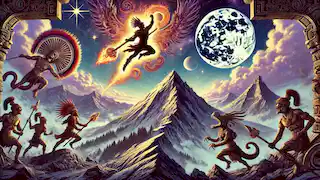
The Rise of the Mexica
Tenochtitlan: The City of the Sun
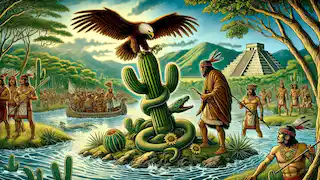
The Eternal Struggle
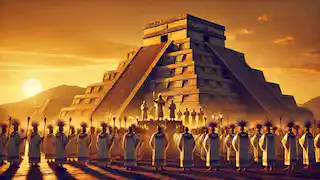
The Fall of Tenochtitlan
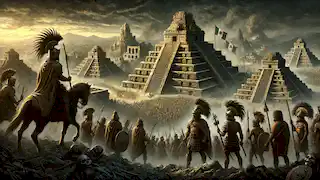
Conclusion
